College basketball’s March Madness is upon us. Chances are you either: A) can’t wait to fill out multiple brackets, B) have grown tired of losing to the guy who fills in the brackets according to school colors, or C) just don’t care about basketball.
Love it, hate it, or indifferent, filling out tournament brackets has become somewhat of a rite of spring. Hot rodders want rites too, so we’ve created a special version of March Madness that all gearheads can get behind: Muscle Car Match-Ups. In this hot-rodded version of the Madness, we’ve placed 16 top muscle cars in a NCAA-style bracket to crown the best muscle car ever. And YOU determine the winner!
How it Works
We’ll present our entire bracket below (Editor’s Note: Yes, we know some great cars didn’t make the cut—you try narrowing it to just 16). You can vote for your first round winners in one of three ways:
- Write all your first round picks in the comments section below.
- Follow OnAllCylinders on Facebook and vote on each individual match-up when we post it. You make your pick by commenting on your favorite.
- Follow Summit Racing Equipment’s Facebook page. Our friends at Summit Racing will post individual, head-to-head match-ups from the tournament, and you can comment on your favorite to vote.
The Bracket (Round 1)
Our bracket consists of just 16 cars, and we tried to include vehicles from a broad spectrum of manufacturers to reflect the wide range of muscle cars that have been offered. With just 16 cars in the first round, some great cars missed our cut for this year–cars like the Pontiac Firebird, Mercury Cougar Eliminator, and others. See who did make the cut below.
1964 Pontiac GTO vs. 1969 Dodge Charger R/T
Widely credited as the car that ushered in the entire muscle car era, the 1964 GTO was actually an option package for the Tempest and sported a 389 cubic inch engine that put out 325 horsepower.
The 1969 Charger reached legendary status on its own, but earned cult status when Bo and Luke piloted a ’69 Charger on TV’s Dukes of Hazzard. We went with the 1969 Charger R/T because of its standard 440-cubic-inch engine and special handling package. (A 426 was also optional.)
1969 Chevrolet Camaro Z/28 vs. 1970 Buick GSX
The Chevrolet Camaro is one of the most famous pony cars of all time and has earned honorary muscle car status with us. The first-generation Camaro is the most sought-after, and its 302-powered Z/28 version was developed for Trans-Am racing.
Buick combined luxury with muscle. The 1970 Buick GSX, which was the high performance package for the Gran Sport and featured a stout 455 cubic-inch engine. The Stage 1 version used a more aggressive cam and higher compression for even greater output.
1970 AMC Rebel “Machine” vs. 1969 Ford Mustang Boss 429
We wanted to include an AMC in our brackets and could’ve easily gone AMX. Instead, we went with the 1970 AMC Rebel “Machine” because it came standard with AMC’s most powerful motor ever—the 340-horse, 390-cubic-inch engine.
Rare but undeniably awesome, the 1969 Ford Boss 429 featured Ford’s 429 cubic-inch engine (go figure). The engine was developed for NASCAR use and built to compete with Mopar’s popular HEMI engine. In the end, only 859 Boss 429s were made, and the car remains highly collect-able.
1970 Dodge Challenger R/T vs. 1970 Oldsmobile 442
The Dodge Challenger R/T arrived late to the muscle car game , but it came in with a loud roar. It was available with some of Mopar’s most potent powerplants, starting with the 383. The 440 and 426 HEMI engine were also options.
The Oldsmobile 442 started as an option package before becoming its own model. Before 1970, General Motors banned engines greater than 400 cubic inches on midsized cars. The ban was lifted, and Oldsmobile began offering the powerful 455 engine in all of its 442s in 1970.
1964 Ford Fairlane Thunderbolt vs. 1970 Plymouth HEMI ‘Cuda
Ford took its largest V8 engine and shoehorned it into the midsize Fairlane body to create the 1964 Ford Fairlane Thunderbolt. Featuring a “high-rise” 427 cubic-inch engine, the Thunderbolt was extremely lightweight and scary fast. A very rare vehicle, only around 100 Thunderbolts were made.
The 1970 Plymouth HEMI ‘Cuda was recently commemorated on the U.S. Postal Service’s latest stamps—and for good reason. The 1970 HEMI ‘Cuda featured Mopar’s brand new E-body, incorporated the almighty HEMI engine, and came standard with a distinctive shaker scoop.
1969 Pontiac GTO (the Judge) vs. 1964 Plymouth Belvedere
Perhaps no muscle car better reflected American culture than the 1969 Pontiac GTO ‘the Judge” model, which was named after a popular comedy routine on Rowan & Martin’s Laugh-In. The Judge had a serious vibe, though, thanks to its standard 400 H.O. Ram Air III engine, Rally II wheels, spoiler, and wide tires.
The 1964 Plymouth Belvedere introduced the world to the 426 HEMI engine. The HEMI-powered ’64 Belvedere was so potent that it won first, second, and third at NASCAR’s 1964 Daytona race. And HEMI fever was born. Need we say more?
1967 Shelby Mustang GT500 vs. 1970 Chevrolet 454 Chevelle SS
The 1967 model year was the first for Carroll Shelby’s legendary GT500. It came equipped with a 428 Police Interceptor engine, and a handful were available with Ford’s race-inspired 427 V8.
When GM lifted its ban on 400-plus cubic-inch motors in mid-sized cars, Chevrolet responded in a big way. Its popular Chevelle SS model was now available with a 454-cubic-inch engine, and an LS6 option gave the Chevelle 454 SS 450 horsepower. It was one of the most powerful vehicles that anyone could purchase.
1968 Plymouth Road Runner vs. 1965 Shelby Cobra 427
Meep-meep. The 1968 Plymouth Road Runner was a hero in that it made muscle cars affordable again. The 383-powered Mopar was all about muscle and offered few amenities. Chrysler passed the savings on to the consumer and a new generation of young enthusiasts was born.
The only car in our brackets to combine American muscle with European styling, the 1965 Shelby Cobra 427 brought together a roadster body with a 510-horsepower, 427-cubic-inch “side-oiler” V8. The Carroll Shelby creation remains one of the quickest cars ever built.
Vote for your winners in the comments section!
Click on the slide show at the top of the post to see the tournament in bracket form and to view OnAllCylinders staff picks. Let the Madness begin! Check out our Round Two post here.

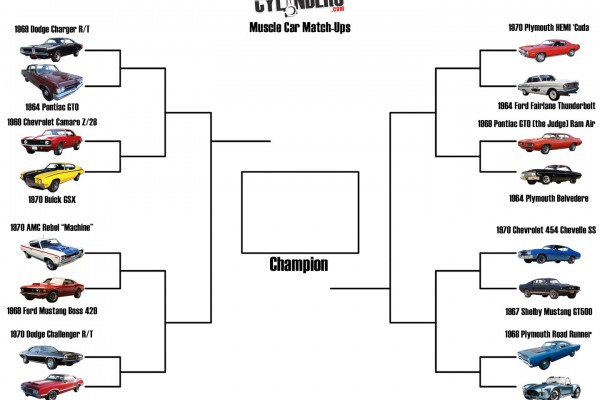
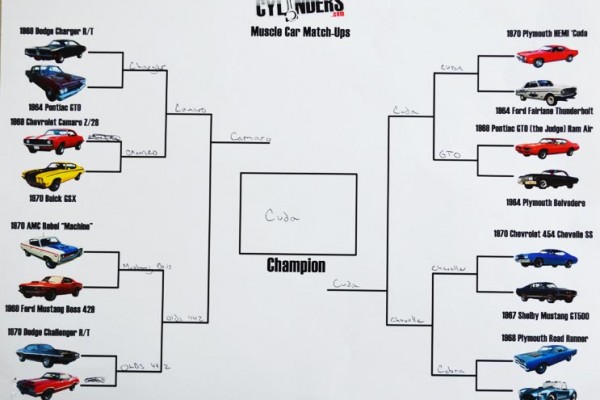










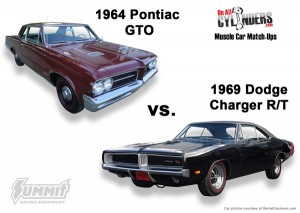
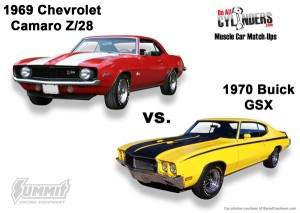
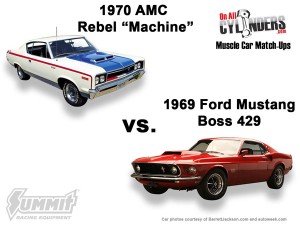
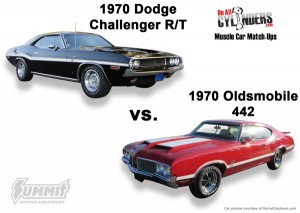
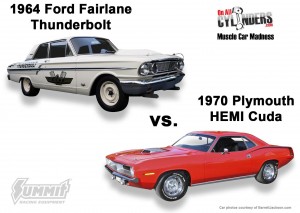
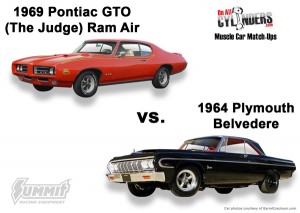
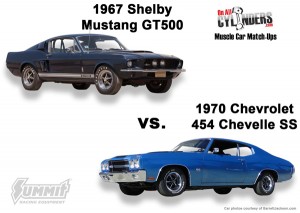
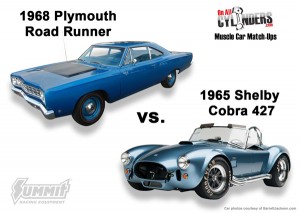
You need to learn that high seeds shouldn’t play high seeds…
It should be belvedere vs 427 cobra… cause there are two many matches i don’t care if both loose and others i wish both would win… seriously this is a crappy bracket..
Gt500 shouldn’t play 454 chevelle in rounds 1, Thunderbolt shouldn’t play HEMI CUDA in round 1 and GTO shouldn’t play Charger in round 1.
Out of those my brand loyalty will win mostly because i can’t vote for a chevy over a good ford so Gt500,
Thunderbolt over hemi cuda not for brand loyalty but because there is a challenger in here too and they’re the same car almost… that… and the thunderbolt would kick it’s butt at the strip.
And gto vs charger… i have to go with the charger just because of the dukes’ and bullet.
for the rest
Obviously the cobra
i HATE the judge so i’ll go with the plymouth.
Challenger wins easy
boss 429 wins easy
and the z 28 wins easy.
69 Charger 69 Z28 69 Boss 429 70 Olds 442 70 Hemi Cuda 69 GTO 70 Chevelle SS 68 RoadRunner
Bracket- Round 1 ’69 Dodge Charger R/T, ’69 Camaro Z28, ’69 BOSS Mustang 429, This next one was a tough pick but, I’m gonna go with the 442. I’ll take the CUDA as my next pick followed by the ’69 Judge, the ’70 SS454 Chevelle, and last but not least… the “65 Shelby Cobra 427. That was FUN!!! j
1969 charger, 1970 Buick GSX, 1969 Boss 429 mustang, 1970 challenger R/T, 1970 Hemicuda, 1969 GTO, 1970 SS 454 chevelle, 1968 Roadrunner.
69 dodge charger, 69 chevy camaro, 69 ford mustang, 70 dodge challenger, 70 hemi cuda, 69 gto, 70 chevelle. 68 road runner
’69 Charger R/T, ’70 Buick GSX, ’69 Mustang BOSS 429, ’70 Olds 442, ’64 Ford Fairlane Thunderbolt, ’69 GTO “Judge”, ’67 Mustang Shelby GT500, ’67 Shelby Cobra 427
1969 Dodge Charger, 1970 Buick GSX, 1969 Ford Mustang Boss, 1970 Dodge Challenger R/T, 1970 Plymouth ‘Cuda, 1964 Plymouth Belvedere, 1970 Chevy Chevelle, 1968 Plymouth Road Runner
Bracket- Round 2 = I’m going with the ’69 Z over the Charger, The BOSS 429 over the 442, The Judge is gonna convict the Cuda, and even though the Cobra is smaller in wheelbase, and weight…I’m gonna take the ’70 SS Chevelle.
idk if you didnt read it, but there only asking for round 1, so everything you posted probably wont count for other rounds. Just make sure you check back in and make sure your other picks make it or they might want to you re-fill it out when they post the next bracket.
Thanx for the warning Matt!!! 🙂 j
’69 Dodge Charger, ’69 Chevrolet Camaro Z28, ’69 Ford Mustang Boss 429, ’70 Dodge Challenger R/T, ’70 Plymouth ‘Cuda, ’69 Pontiac GTO Judge, ’70 Chevrolet Chevelle 454SS, ’65 Shelby Cobra 427.
69 charger, buick GSK, boss mustang, olds 442, Hemi cuda, The judge, 70 chevelle ss, cobra
Bracket-Round 3= Down to the Head to Head competition. I gotta say that the 429 Boss gets the better of the Z, and that the ’70 SS benches the Judge.
’69 charger, ’70 buick gsx, ’69 mustang boss 429, ’70 olds 442, ’70 HEMI cuda, ’64 Plymouth belvedere, ’67 Shelby mustang gt 500, ’68 Plymouth roadrunner
Bracket- Round 4= The crowning of a champion. I’m saying that the ’70 SS Chevelle is the undisputed winner, and King of these Musclecars.
69 charger, 69 camaro, 69 mustang, 70 challenger, 70 cuda, 69 gto, 70 chevelle, 65 cobra
Round #2-’69 Z28 over ’68 Charger RT, ’69 Boss 429 over ’70 Challenger, ’70 Hemi ‘Cuda over ’69 GTO Judge, ’70 Chevelle 454SS over ’65 Cobra 427. That’s not easy, do I have to keep going? lol
64 GTO, 69 Z/28, 69 Boss, 70 R/T, 70 Cuda, 69 GTO, 70 Chevelle, 65 Cobra
1969 Dodge Charger R/T
1970 Buick GSX
1969 Ford Mustang Boss 429
1970 Dodge Challenger R/T
1970 Plymouth HEMI Cuda
1969 Pontiac GTO (The Judge) Ram Air
1970 Chevrolet 454 Chevelle SS
1965 Shelby Cobra 427
1969 Charger R/T
1970 Buick GSX
1969 Ford Boss 429
Oldsmobile 442
1970 Plymouth HEMI ‘Cuda
1969 Pontiac GTO ‘the Judge”
GT500
1965 Shelby Cobra 427
69 Charger, 69 Camaro, 69 Mustang, 70 Challenger, 70 Cuda, 69 GTO, 70 Chevelle, 68 Roadrunner
1969 Dodge Charger R/T
1969 Chevrolet Camaro Z/28
1970 AMC Rebel “Machine”
1970 Oldsmobile 442
1970 Plymouth HEMI ‘Cuda
1969 Pontiac GTO (the Judge) Ram Air
1970 Chevrolet 454 Chevelle SS
1965 Shelby Cobra 427
69 Charger R/T
70 Buick GSX
69 Mustang Boss 429
70 Challenger R/T
70 Plymouth HEMI Cuda
64 Plymouth Belvedere
70 Chevelle 454
as much as this pains me….65 Shelby Cobra
69 dodge charger r/t,69 chevy camaro z/28,69 ford mustang boss,70 dodge challenger,70 plymouth hemi cuda,69 pontiac gto,70 chevy chevelle ss,68 plymouth roadrunner.
64 GTO, 69 Camaro, 69 Mustang, 70 442, 70 Cuda, 69 GTO, 70 Chevelle, 68 Roadrunner
69 Charger, 69 Camaro 69 boss 429 Mustang, 70 Challenger, 64 T-Bolt, 64 Belvedere, 67 Shelby gt500, 65 Shelby Cobra
69 Charger R/T, 69 Z/28, 69 Boss 429, 70 Olds 442, 70 ‘Cuda, 69 GTO Judge, 67 Shelby GT500, 65 Shelby Cobra 427
69 dodge charger, 69 chevy camaro, 69 ford mustang, 70 dodge challenger, 70 plymouth hemi cuda, 69 GTO Judge, 70 chevy chevelle ss, 65 shelby cobra
64 GTO,69 Camaro Z-28,70 Rebel Machine,70 Challenger RT,64 Ford Thunderbolt,64 Plymouth Belvedere,70 Chevelle SS454,68, Roadrunner
1969 Dodge Charger R/T, 1970 Buick GSX, 1970 AMC Rebel “Machine”, 1970 Oldsmobile 442, 1970 Plymouth HEMI ‘Cuda, 1969 Pontiac GTO (the Judge), 1970 Chevrolet 454 Chevelle SS, 1968 Plymouth Road Runner
1969 Dodge Charger R/T,1969 Chevrolet Camaro Z/28, 1969 Ford Mustang Boss 429, 1970 Dodge Challenger R/T, 1970 Plymouth HEMI ‘Cuda’, 1969 Pontiac GTO (the Judge), 1970 Chevrolet 454 Chevelle SS, 1965 Shelby Cobra 427
69 Charger, 70 Buick, 69 Mustang, 70 Challenger, 64 Thunderbolt, 64 Belvedere, 67 Shelby, 65 Cobra
round 1: 1964 Pontiac GTO, 1969 Camaro Z28, 1970 AMC Rebel “machine”, 1970 Oldsmobile 442, 1970 Plymouth Hemi cuda, 1969 Pontiac GTO “The Judge”, 1970 Chevrolet Chevell SS454, 1968 Plymouth Road Runner.
I say for round 1, 69 charger, 70 gsx, 69 boss 429 mustang, 70 challenger, 70 hemi cuda, 64 belvedere, 67 gt 500, and finally the 65 shelby cobra 427 ( even though I prefer mopar, the 427 is just way more powerful than a 383).
69 Dodge Charger, 69 Camaro, 70 AMC Rebel, 70 Challenger, 70 Plmouth Hemi Cuda, 64 Plymouth Belvedere, 67 Shelby Mustang, 68 Plymouth Roadrunner
64 GTO, 69 Camaro Z28, 70 AMC rebel “machine”, 70 442, 70 cuda, 69 GTO, 70 chevelle 454, 65 cobra 427
69 Dodge Charger, 70 Buick GSX, 69 Ford Mustang, 70 Dodge Challenger, 70 Plymouth Cuda, 64 Plymouth Belvedere, 67 Shelby Mustang GT500, 68 Plymouth Road Runner
Charger, Camaro, Mustang, Challenger, Cuda, Belvy, Chevelle, Roadrunner
round I , 69 Dodge Charger, 70 Buick GSX, 69 Boss Mustang, 70 Olds 442 , 70 Plymouth Cuda, 69 Pontiac GTO, 70 Chevelle SS, 65 Shelby Cobra,
ROUND 1==== 69 charger,70 GSX,69 mustang,70 442,64 thunderbolt,64 belvedere,70 chevelle and at the finesh line ,the 65 Cobra 427 so lets play ball…LOL
64 GTO; 70 Buick GSX; 69 Boss 429 Mustang; 70 Olds 442; 70 Hemi Cuda; 69 GTO; 70 Chevelle SS454; 65 Shelby Cobra 427
Round 1, 64 Pontiac GTO, 70 Buick GSX, 69 Ford Boss 429, 70 Olds 442, 64 Ford Thunderbolt, 64 Plymouth Belvedere, 70 Chevy 454 SS, 65 Ford Cobra
ss454 chevelle69 gto 1969 z28 1968 road runner 1964 thunderbolt 70 olds 442 70 amc and the one that started it all 64 gto
what no mercury cyclone? where’s the javelin, 440 duster, don’t tell me i imagined all those other nice cars?
69 Charger , 70 Buick GSX , 69 Ford Mustang Boss 429, 70 Dodge Challenger R/T, 70 Plymouth Hemi Cuda, 64 Plymouth Belvedere, 70 Chevrolet Chevelle 454 SS, 1968 Plymouth Road Runner
1969 Dodge Charger R/T,1969 Chevrolet Camaro Z/28, 1969 Ford Mustang Boss 429, 1970 Oldsmobile 442, 1970 Plymouth HEMI Cuda, 1969 Pontiac GTO (The Judge) Ram Air, 1970 Chevrolet 454 Chevelle SS, 1965 Shelby Cobra 427.
69 Dodge Charger R/T, 70 Buick GSX, 69 Ford Mustang Boss 429, 70 Dodge Challenger R/T, 64 Ford Fairlane Thunder Bolt, 69 Pontiac GTO Judge Ram Air, 70 Chevelle 454SS, 65 Shelby Cobra 427
69 Charger, Buick GSX, Boss 429, Challenger R/T, Thunderbolt, Belvedere, 454 Chevelle, Cobra
64 GTO; 70 GSX; 70 AMC rebel machine; 70 challenger; 70 hemi cuda; 69 GTO; 70 chevelle; 65 Shelby Cobra
69 charger, 69 camaro, rebel machine, 70 challenger, 70 hemi cuda, 69 gto, 70 chevelle, shelby cobra
69 Charger, 70 Buick GSX, 70 AMC Rebel “Machine”, 70 Challenger R/T, 70 Plymouth HEMI Cuda, 64 Plymouth Belvedere, 67 Shelby GT500, 68 Plymouth Roadrunner. GO MOPAR!!!
1969 Dodge Charger R/T, 1970 Buick GSX, 1969 Ford Mustang Boss 429, 1970 Dodge Challenger R/T, 1970 Plymouth HEMI ‘Cuda, 1969 Pontiac GTO (the Judge), 1967 Shelby Mustang GT500, and 1965 Shelby Cobra 427
69 Dodge Charger,69 Chevy Camaro,69 Ford Mustang Boss 429,70 Dodge Challenger,64 Ford Fairlane Tunderbolt,64 Plymouth Belvedere,67 Shelby Mustang GT500,65 Shelby Cobra 427.
69 charger, 69 Camaro, 70 rebel, 70 442, 70 cuda, 69 GTO, 70 chevelle, and 65 cobra.
round 2…69 dodge charger, 70 dodge challenger, 64 plymouth belvedere, 68 plymouth roadrunner…round 3 69 dodge charger, 68 plymouth roadrunner and the winner is 68 ROADRUNNER but then all Mopar’s are winners
1969 Dodge Charger, 1969 Camaro, 1969 Boss 429, 1970 Challenger, 1970 ‘Cuda, GTO Judge, Shelby GT 500, 1968 Road Runner.
1969 charger
1969 camaro
1969 boss 429
1970 olds 442
1970 hemi cuda
1964 belvedere
1970 ls6 chevelle
1968 roadrunner
69 dodge charger,70 buick gsx,boss 429,olds 442,hemicuda,69 gto judge, 70 chevelle 454ss,66 cobra.
1969 Dodge Charger R/T,1969 Chevrolet Camaro Z/28 , 1969 Ford Mustang Boss 429, 1970 Oldsmobile 442, 1970 Plymouth HEMI ‘Cuda,1969 Pontiac GTO (the Judge),1967 Shelby Mustang GT500,1965 Shelby Cobra 427
Round 1 goes to – 64 Pontiac GTO, 68 Chevy Camaro Z28, 68 Ford Mustang, 710 Olds 442, 73 Plymouth Cuda, 69 Pontiac GTO (Judge), 70 Chevy Chevelle, 65 Shelby Cobra.
69 Charger R/T, 69 Camaro Z-28, 69 Mustang 429, 70 Olds 442, 70 Plymouth HEMI ‘Cuda, 69 Pontiac GTO, 70 Chevelle 454SS 65 Shelby Cobra 427
69 Charger, 69 Camaro, 69 Boss 429, 70 Challanger, 64 Thunderbolt, 69 GTO Judge, 67 Shelby GT 500, 65 Cobra 427
64 GTO, 69 Camaro Z28, 69 Boss 429, 70 Olds 442, 64 Thunderbolt, 64 Belvedere, 70 SS454, 65 shelby 427. some of these are reallly lopsided……
’69 Charger R/T, ’69 Camaro Z/28, ’69 Boss 429, ’70 Challenger R/T, ’70 Cuda, ’69 GTO Judge, ’70 454 Chevelle, ’65 Cobra
69 Charger, 69 Z/28, 69 Mustang, 70 Challenger, 64 Thunderbolt, 69 GTO, 67 Shelby GT 500, 65 Shelby Cobra
Gto
Camaro
Mustang
Olds 442
Cuda
Judge
Chevelle
Shelby cobra
69 z28 camaro 64 gto69 boss 429olds 44270 cuda 69 Gto “the judge” 67 gt500 65 Shelby cobra 427……… But why couldn’t they bring out the Yenko camaros and novas???
69 Charger, 70 GSX, 69 Boss 429, 70 Challenger R/T, 70 Hemi Cuda, 69 GTO, 67 GT 500, 68 Road Runner
gto, camaro, mustang, challenger, cuda, judge, chevelle, road runner
69 Charger
70 Buick GSX
69 Boss 429
70 Challenger R/T
70 Hemi Cuda
69 GTO
70 Chevelle SS 454
65 Shelby Cobra
69 charger , 69 camaro, 69 mustang, 70 challenger, 70 cuda, 69 GTO, 67 GT500, 65 cobra
’69 Charger R/T, ’70 Buick GSX, ’69 Mustang Boss 429, ’70 Olds 442, ’64 Ford Thunderbolt, ’64 Plymouth Belvedere, ’70 Chevelle SS454, ’65 Shelby Cobra 427
Charger
GSX
Boss
Challenger
Cuda
Judge
Chevelle
Cobra
69 charger r/t , 70 buick csx , 70 amc rebel , 70 challenger r/t , 70 plymouth hemi cuda , 69 gto , 70 chevrolet chevelle , 68 plymouth rr
64 GTO, 69 z/28, 69 Boss 429, 70 Dodge Challenger, 70 Hemi Cuda, 69 GTO, 70 Chevelle, 68 Road Runner
69 Charger, 69 Camaro, 69 Stang, 70 Olds 442, 70 Cuda, 69 GTO, 67 GT500, and 68 Road Runner.
Charger, GSX,Boss 429, Challenger RT,Thunderbolt, GTO, GT500, Cobra.
64 GTO,69 Camaro,70 AMC,70 Challenger,70 HEMI Cuda,69 Judge,70 CHevelle SS,65 Shelby
69 Charger R/T, 70 Buick GSX, 69 Boss 429, 70 Olds 442, 64 Thunderbolt, 64 Belvedere, 70 Chevelle, Shelby Cobra 427.
69 Charger R/T, 70 Buick GSX, 69 Boss Mustang, 70 Challenger R/T, 70 Hemi Cuda, 69 GTO Judge, 70 Chevelle SS, 65 Shelby Cobra.
69 Charger, 70 Buick GSX, 69 Boss 429, 70 Challenger, 64 Fairlane Thunderbolt, 60 GTO, 67 Shelby Mustang, 65 Shelby Cobra 427
gto, Camaro, mustang, challenger, cuda,gto chevelle, road runner
Charger, GSX, Boss 429, Challenger R/T, Thunderbolt, Belvedere, Chevelle, Cobra…..
1969 Dodge Charger R/T, 1969 Chevrolet Camaro Z/28, 1970 AMC Rebel “Machine”, 1970 Dodge Challenger R/T, 1970 Plymouth Hemi Cuda, 1969 Pontiac GTO (The Judge), 1970 Chevrolet 454 Chevelle, 1968 Plymouth Road Runner
Really? NOBODY picks the GSX? Does anyone realize that of all the cars on here, it had the most torque. And what wins races when horsepower and weights are fairly close? torque
69 charger,GSX,mustang,challenger,cuda,GTO,Chevelle,Cobra
’69 Charger R/T; ’69 Chev Camaro Z28; ’69 Ford Mustang Boss 429; ’70 Dodge Challenger R/T; ’64 Ford Fairlane Thunderbolt; ’64 Plymouth Belvedere; ’67 Shelby Mustang GT 500; ’65 Shelby Cobra 427
69 Charger, 69 Mustang, 70 Challenger, 69 Camaro, 70 Cuda, 69 GTO, 67 Shelby, 68 Roadrunner
69 Charger, 70 Buick, 69 Boss Mustang, 70 Challenger, 64 Thunderbolt, 64 Belvadere, 70 Chevelle, 65 Cobra.
hello ok here goes : charger,camaro,mustange,challenger,plymouth,GTO,Chevelle,Cobra:: Champion:Shelby Cobra:::
Charger, Z-28, Boss 429 Mustang, Challenger, Thunderbolt, Belevedere, Shelby Mustang, Shelby Cobra
69 Charger R/T 70 Buick GSX 70 AMC Rebel Machine 70 Dodge Challenger R/T 70 Hemi Cuda 64 Belvedere 70 454 Chevell SS 68 Road Runner
64 GTO, 70 GSX, 69 Mustang Boss 429, 70 Challenger R/T, 70 Hemi Cuda, 64 Belvedere Hemi, 70 Chevelle SS 455 LS6, 65 Shelby Cobra 427.
69 dodge, 69 Camaro, 69 ford, 70 dodge, 64 ford, 64 Plymouth, 67 ford, 65 cobra.
GTO, Z/28, Boss 429, 442, Hemi ‘Cuda, GTO Judge, 454 SS Chevelle, Road Runner.
what about a 1974 Pontiac Ventura one of the most rarest cars on the block they only made 1600 of them in 1974 I have ne of the few the rest must be in junk yards you don’t see to many left
1969 dodge charger, 1970 Buick GSX, 1969 Boss 429 mustang, 1970 dodge challenger, 1964 thunderbolt, 1964 belvedere, 1970 chevelle ,1965 cobra
64gto
AMC Rebel Machine!!!
Ford Rule
69 charger,70 buick gsx, 70 AMC rebel machine ,70 challenger, 64 t-bolt, 64 belvedere, 70 chevelle, 68 road runner.
69 Charger RT,70 GSX,69 Boss 9,70 Challenger RT,64 TBolt,69 Judge,70 SS 454,(Sorry Steve! ) and the 65 427 Cobra.
Mustang, Fairlaine, GT500, Cobra.
69 charger, 70 GSX, 70 Rebel Machine, 70 442, 70 Hemi Cuda, 69 GTO Judge, 70 SS 454, 68 Roadrunner.
Charger, GSX, Mustang, Challenger, Cuda, GTO, Chevelle, Cobra.
Round 1 picks:1964 Pontiac GTO, 1970 Buick GSX, 1969 Ford Mustang Boss 429,1970 Dodge Challenger R/T, 1970 Plymouth Hemi-Cuda, 1964 Plymouth Belvedere, 1967 Shelby GT 500 Mustang, and 1965 Shelby Cobra 427.
64 GTO, 69 Z28, 69 Boss Mustang, 70 Challenger, 64 Thunderbolt, 64 Belvedere, 67 GT500, 65 Cobra 427.
’69 Charger R/T – ’69 Z28 – ’69 Boss 429 – ’70 442 – ’70 Hemi ‘Cuda – ’69 Judge – ’67 Shelby GT-500 – ’68 Road Runner.
1969 Dodge Charger R/T, 1970 Buick GSX, 1970 AMC Rebel “Machine”, Oldsmobile 442, 1970 Plymouth HEMI ‘Cuda, 1969 Pontiac GTO ‘the Judge”, 1970 Chevrolet 454 Chevelle SS, 1965 Shelby Cobra 427.
69 CHARGER, 70 GSX, 69 BOSS MUSTANG, 70 CHALLENGER RT, 64 THUNDERBOLT, 64 BELVEDERE, 70 CHEVELLE SS, 427 COBRA.
Round 1 – 69 Charger, 70 GSX, 69 Boss 429, 70 Olds 442, 70 Hemi Cuda, 69 GTO Judge, 70 Chevelle, 68 Road Runner
69 Charger, 69 Camaro, 69 Boss, 70 Challenger, 70 Cuda, 69 GTO, 70 Chevelle, 65 Cobra
Very difficult to pick, I love ‘em all!
1969 Dodge Charger R/T; 1969 Chevrolet Camaro Z/28; 1970 AMC Rebel “Machine”;.
1970 Oldsmobile 442; 1970 Plymouth HEMI Cuda; 1969 Pontiac GTO Ram Air; 1970 Chevrolet 454 Chevelle SS; 1968 Plymouth Road Runner.
gto, boss 429, challenger, cuda, the judge, mustang gt 500, shelby.
Charger RT, Buick GSX, Mustang Boss, Challenger RT, Plymouth Hemi Cuda, Plymouth Belvedere, Shelby Mustang, Plymouth Road Runner (Just because it is an awesome car and my brother had one!)
Round 1: 69 Charger R/T, 70 Buick GSX, 69 Boss 429, 70 Olds 442, 70 Hemi Cuda, 64 Belvidere, 70 SS454, 68 Road Runner.
The Brackett (Round 1) 1969 Dodge Charger R/T, 1970 Buick GSX, 1969 Ford Mustang Boss 429, 1970 Dodge Challenger R/T, 1964 Ford Fairlane Thunderbolt, 1964 Plymouth Belvidere, 1970 Chevrolet 454 Chevelle SS, 1965 Shelby Cobra 427.
69 Dodge Charger, 69 Chevy Camaro, 70 Ford Mustang, 70 Dodge Challenger, 70 Plymouth Cuda, 69 Pontiac GTO, 70 Chevy Chevelle, 68 Plymouth Roadrunner.
69 charger, 69 camaro, 69 boss mustang, 70 oldsmobile 442, 70 cuda, 69 gto judge, 70 chevelle, 68 roadrunner.
Round 1- 69 Charger, 69 Camaro, 69 Mustang, 70 Challenger, 64 Fairlane, 64 Belvedere, 70 Chevelle, 65 Cobra. Some of these match ups could go either way depending on the drivers.
Round 1, ’69 Charger, Buick GSX, Boss 429 Mustang, Olds 442 (unless the Challenger had a 440, Thunderbolt, ’64 Belvedere, SS 454 Chevelle, 427 Cobra.
[…] It wasn’t exactly Florida Gulf Coast University over Georgetown, but some of us raised our eyebrows when, per your votes, the 1970 Buick GSX took out the venerable 1969 Chevy Camaro Z/28 in the first round of Muscle Car Match-Ups. […]
[…] can revisit our first Muscle Car Match-Ups post, along with our round two post, to see the complete brackets and review how each semi-finalist made […]
[…] how we described the Boss 429 in our original Muscle Car Match-Ups post, and many of you obviously agree. The Boss 429 has proven to be a Dodge killer in this tournament, […]
[…] Cobra overcame incredible odds to earn the championship, including near exclusion from the original field of 16. After much internal debate about labeling the Cobra as a muscle car, we opted to include this […]